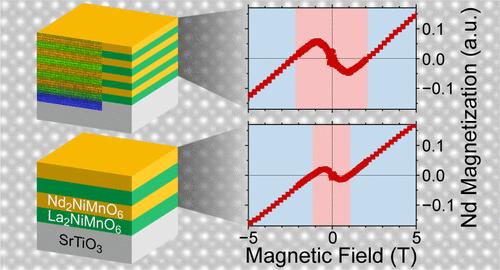设计氧化物异质结构中的磁转变温度和稀土交换相互作用
IF 16
1区 材料科学
Q1 CHEMISTRY, MULTIDISCIPLINARY
引用次数: 0
摘要
功能氧化物异质结构的性质受到控制其界面的物理特性的强烈影响。现代沉积技术使我们能够通过生长原子精确的异质结构来精确地设计界面物理。这使得对电子、磁性和结构特性的微小控制成为可能,从而可以调整异质结构的特性,甚至可以导致单个异质结构组件中不存在的特性的出现。在这里,我们研究了使用铁磁性和绝缘双钙钛矿RE2NiMnO6 (RE = La, Nd)定制的具有不同居里温度的超晶格的磁性。调整超晶格的周期性使我们能够设计磁相图。大的周期性超晶格保留了La2NiMnO6和Nd2NiMnO6亲本化合物的个别对铁磁跃迁。随着超晶格周期性的降低,超晶格组分的居里温度收敛,并最终在最低周期样品中坍缩成一个单一的跃迁,说明低周期性超晶格表现为一种独特的材料。这是磁序参数在超晶格界面上传播的结果,由最小朗道理论模型支持。此外,我们发现超晶格界面可以增强Nd-Ni-Mn交换相互作用。这导致磁场诱导的Nd磁矩反转,正如同步加速器x射线磁圆二色性测量所证实的那样,并得到第一性原理计算的支持。我们的工作展示了如何利用超晶格工程来微调氧化物异质结构的磁性,并拓宽了我们对磁性界面效应的理解。本文章由计算机程序翻译,如有差异,请以英文原文为准。

Engineering the Magnetic Transition Temperatures and the Rare Earth Exchange Interaction in Oxide Heterostructures
The properties of functional oxide heterostructures are strongly influenced by the physics governing their interfaces. Modern deposition techniques allow us to accurately engineer interface physics through the growth of atomically precise heterostructures. This enables minute control over the electronic, magnetic, and structural characteristics, which in turn allows for the tuning of the properties of the heterostructures and can even lead to the emergence of properties not present in the individual heterostructure components. Here, we investigate the magnetic properties of tailor-made superlattices employing the ferromagnetic and insulating double perovskites RE2NiMnO6 (RE = La, Nd), featuring distinct Curie temperatures. Adjusting the superlattice periodicity at the unit cell level allows us to engineer the magnetic phase diagram. Large periodicity superlattices conserve the individual para- to ferromagnetic transitions of the La2NiMnO6 and Nd2NiMnO6 parent compounds. As the superlattice periodicity is reduced, the Curie temperatures of the superlattice constituents converge and, finally, collapse into one single transition for the lowest period samples, illustrating that low-periodicity superlattices behave as a unique material. This is a consequence of the magnetic order parameter propagating across the superlattice interfaces, as supported by a minimal Landau theory model. Further, we find that the Nd–Ni–Mn exchange interaction can be enhanced by the superlattice interfaces. This leads to a field-induced reversal of the Nd magnetic moments, as confirmed by synchrotron X-ray magnetic circular dichroism measurements and supported by first-principles calculations. Our work demonstrates how superlattice engineering can be employed to fine-tune the magnetic properties in oxide heterostructures and broadens our understanding of magnetic interfacial effects.
求助全文
通过发布文献求助,成功后即可免费获取论文全文。
去求助
来源期刊

ACS Nano
工程技术-材料科学:综合
CiteScore
26.00
自引率
4.10%
发文量
1627
审稿时长
1.7 months
期刊介绍:
ACS Nano, published monthly, serves as an international forum for comprehensive articles on nanoscience and nanotechnology research at the intersections of chemistry, biology, materials science, physics, and engineering. The journal fosters communication among scientists in these communities, facilitating collaboration, new research opportunities, and advancements through discoveries. ACS Nano covers synthesis, assembly, characterization, theory, and simulation of nanostructures, nanobiotechnology, nanofabrication, methods and tools for nanoscience and nanotechnology, and self- and directed-assembly. Alongside original research articles, it offers thorough reviews, perspectives on cutting-edge research, and discussions envisioning the future of nanoscience and nanotechnology.
 求助内容:
求助内容: 应助结果提醒方式:
应助结果提醒方式:


